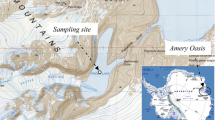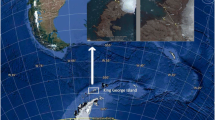Abstract
In situ analysis of the 16S rRNA genes from bacterial mats of five hydrothermal springs (36–58°C) in the Uzon caldera (Kamchatka, Russia) was carried out using clone libraries. Eight clone libraries contained 18 dominant phylotypes (over 4–5%). In most clone libraries, the phylotype of the green sulfur bacterium Chlorobaculum sp. was among the dominant ones. The phylotypes of the green nonsulfur bacteria Chloroflexus and Roseiflexus and of purple nonsulfur bacteria Rhodoblastus, Rhodopseudomonas, and Rhodoferax were also among the dominant ones. Cyanobacteria were represented by one dominant phylotype in a single spring. Among nonphototrophic bacteria, the dominant phylotypes belonged to Sulfyrihydrogenibium sp., Geothrix sp., Acidobacterium sp., Meiothermus sp., Thiomonas sp., Thiofaba sp., and Spirochaeta sp. Three phylotypes were not identified at the genus level. Most genera of phototrophic and nonphototrophic organisms corresponding to the phylotypes from Uzon hydrotherms have been previously revealed in the hydrotherms of volcanically active regions of America, Asia, and Europe. These results indicate predominance of bacterial mats carrying out anaerobic photosynthesis in the hydrotherms of the Uzon caldera.
Similar content being viewed by others
References
Gorlenko, V.M., Anoxygenic phototrophic bacteria, in Proc. Winogradsky Inst. Microbiol., vol. 15, Photosynthetic Bacteria, Gal’chenko, V.F., Ed., Moscow: MAKS Press, 2010, pp. 133–174.
Madigan, M.T., Jung, D.O., Karr, E.A., Sattley, W.M., Achenbach, L.A., and van der Meer, M.T.J., Diversity of anoxygenic phototrophs in contrasting extreme environments, in Geothermal Biology and Geochemistry in Yellowstone National Park, Inskeep, W.P. and McDermott, T.R., Eds., Bozeman, MT: Montana State Univ. Thermal Biol. Inst., 2005, pp. 203–219.
Ward, D.M. and Cohan, F.M., Microbial diversity in hot spring cyanobacterial mats: pattern and prediction, in Geothermal Biology and Geochemistry in Yellowstone National Park, Inskeep, W.P. and McDermott, T.R., Eds., Bozeman, MT: Montana State Univ. Thermal Biol. Inst., 2005, pp. 185–202.
Ferris, M.J. and Ward, D.M., Seasonal distributions of dominant 16S rRNA-defined populations in a hot spring microbial mat examined by denaturing gradient gel electrophoresis, Appl. Environ. Microbiol., 1997, vol. 63, pp. 1375–1381.
Allewalt, J.P., Bateson, M.M., Revsbech, N.P., Slack, K., and Ward, D.M., Effect of temperature and light on growth of and photosynthesis by Synechococcus isolates typical of those predominating in the Octopus Spring microbial mat community of Yellowstone National Park, Appl. Environ. Microbiol., 2006, vol. 72, pp. 544–550.
van der Meer, M.T.J., Klatt, C.G., Wood, J., Bryant, D.A., Bateson, M.M., Lammerts, L., Schouten, S., Sinninghe Damste, J.S., Madigan, M.T., and Ward, D.M., Cultivation and genomic, nutritional, and lipid biomarker characterization of Roseiflexus strains closely related to predominant in situ populations inhabiting Yellowstone hot spring microbial mats, J. Bacteriol., 2010, vol. 192, pp. 3033–3042.
Gorlenko, V.M., Bonch-Osmolovskaya, E.A., Kompantseva, E.I., and Starynin, D.A., Differentiation of microbial communities in connection with a change in the physicochemical conditions in thermophile spring, Microbiology (Moscow), 1987, vol. 56, pp. 250–257.
Gorlenko, V.M., Starynin, D.A., Bonch-Osmolovskaya, E.A., and Kachalkin, V.I., Production processes in microbial cenoses of the Thermofil’nyi Hot Spring Microbiology (Moscow), 1987, vol. 56, pp. 692–697.
Bej, A.K., Mahbubani, M.H., Dicesare, J.L., and Atlas, R.M., Polymerase chain reaction-gene probe detection of microorganisms by using filter-concentrated samples, Appl. Environ. Microbiol, 1991, vol. 57, pp. 3529–3534.
Ausubel, F.M., Brent, R., Kingston, R.E., Moore, D.D., Seidman, J.G., Smith, J.A., and Struhl, K., Current Protocols in Molecular Biology, New York: Wiley, 1994.
Alexandrov, A., Kaushik, D., and Pascal, S.M., Streamline method to analyze 16S rRNA gene clone libraries, BioTechniques, 2001, vol. 30, pp. 938–944.
Thompson, J.D., Higgins, D.G., and Gibson, T.J., CLUSTAL W: improving the sensitivity of progressive multiple sequence alignment through sequence weighting, position specific gap penalties and weight matrix choice, Nucleic Acids Res., 1994, vol. 22, pp. 4673–4680.
Van de Peer, Y. and De Wachter, R., TREECON for Windows: a software package for the construction and drawing of evolutionary trees for the Microsoft Windows environment, Comput. Appl. Biosci., 1994, vol. 10, pp. 569–570.
Salonen, A., Nikkilä, J., Jalanka-Tuovinen, J., Immonen, O., Rajilić-Stojanović, M., Kekkonen, R.A., Palva, A., and de Vos, W.M., Comparative analysis of fecal DNA extraction methods with phylogenetic microarray: effective recovery of bacterial and archaeal DNA using mechanical cell lysis, J. Microbiol. Methods, 2010, vol. 81, pp. 127–134.
Chernousova, E.Yu., Akimov, V.N., Gridneva, E.V., Dubinina, G.A., and Grabovich, M.Yu., Phylogenetic in situ/ex situ analysis of a sulfur mat microbial community from a thermal sulfide spring in the North Caucasus, Microbiology (Moscow), 2008, vol. 77, pp. 219–223.
Castenholz, R.W., Bauld, J., and Jørgenson, B.B., Anoxygenic microbial mats of hot springs: thermophilic Chlorobium sp., FEMS Microbiol. Lett., 1990, vol. 74, pp. 325–336.
Wahlund, T.M., Woese, C.R., Castenholz, R.W., and Madigan, M.T., A thermophilic green sulfur bacterium from New Zealand hot springs, Chlorobium tepidum sp. nov., Arch. Microbiol., 1991, vol. 156, pp. 81–90.
Imhoff, J.F., Phylogenetic taxonomy of the family Chlorobiaceae on the basis of 16S rRNA and fmo (Fenna-Matthews-Olson protein) gene sequences, Int. J. Syst. Evol. Microbiol., 2003, vol. 53, pp. 941–951.
Hanada, S., Takaichi, S., Matsuura, K., and Nakamura, K., Roseiflexus castenholzii gen. nov., sp. nov., a thermophilic, filamentous, photosynthetic bacterium that lacks chlorosomes, Int. J. Syst. Evol. Microbiol., 2002, vol. 52, pp. 187–193.
O’Neill, A.H., Liu, Y., Ferrera, I., Beveridge, T.J., and Reysenbach, A.L., Sulfurihydrogenibium rodmanii sp. nov., a sulfur-oxidizing chemolithoautotroph from the Uzon Caldera, Kamchatka Peninsula, Russia, and emended description of the genus Sulfurihydrogenibium, Int. J. Syst. Evol. Microbiol., 2008, vol. 58, pp. 1147–1152.
Vesteinsdottir, H., Reinisdottir, D.B., and Örlygsson, N.J., Thiomonas islandica sp. nov., a moderately thermophilic hydrogen- and sulfur-oxidizing betaproteobacterium isolated from a hot spring, Int. J. Syst. Evol. Microbiol., 2011, vol. 61, pp. 132–137.
Mori, K. and Suzuki, K., Thiofaba tepidiphila gen. nov., sp. nov., a novel obligately chemolithoautotrophic, sulfur-oxidizing bacterium of the Gammaproteobacteria isolated from a hot spring, Int. J. Syst. Evol. Microbiol., 2008, vol. 58, pp. 1885–1891.
Aksenova, H.Y., Rainey, F.A., Janssen, P.H., Zavarzin, G.A., and Morgan, H.W., Spirochaeta thermophila sp. nov., an obligately anaerobic, polysaccharolytic, extremely thermophilic bacterium, Int. J. Syst. Bacteriol., 1992, vol. 42, pp. 175–177.
Pohlschroeder, M., Leschine, S.B., and Canale-Parola, E., Spirochaeta caldaria sp. nov., a thermophilic bacterium that enhances cellulose degradation by Clostridium thermocellum, Arch. Microbiol., 1994, vol. 161, pp. 17–24.
Gorlenko, V.M., Kompantseva, E.I., and Puchkova, N.N., Influence of temperature on prevalence of phototrophic bacteria in hot springs, Microbiology (Moscow), 1985, vol. 54, pp. 681–685.
Bateson, M.M., Wieland, A., and Ward, D.M., Microscopic examination of distribution and phenotypic properties of phylogenetically diverse Chloroflexaceae- related bacteria in hot spring microbial mats, Appl. Environ. Microbiol., 2002, vol. 68, pp. 4593–4603.
Marcel, T.J., van der Meer, M.T.J., Klatt, C.G., Wood, J., Bryant, D.A., Bateson, M.M., Lammerts, L., Schouten, S., Damsté, J.S.S., Madigan, M.T., and Ward, D.M., Cultivation and genomic, nutritional, and lipid biomarker characterization of Roseiflexus strains closely related to predominant in situ populations inhabiting Yellowstone hot spring microbial mats, J. Bacteriol., 2010, vol. 192, pp. 3033–3042.
Hall, J.R., Mitchell, K.R., Jackson-Weaver, O., Kooser, A.S., Cron, B.R., Crossey, L.J., and Takacs-Vesbach, C.D., Molecular characterization of the diversity and distribution of a thermal spring microbial community by using rRNA and metabolic genes, Appl. Environ. Microbiol., 2008, vol. 74, pp. 4910–4922.
Giovannoni, S.J., Ward, D.M., Pevsbech, N.P., and Castenholz, R.W., Obligately phototrophic Chloroflexus: primary production in anaerobic, hot spring microbial mats, Arch. Microbiol., 1987, vol. 147, pp. 80–87.
Madigan, M.T., Chromatium tepidum sp. nov., a thermophilic photosynthetic bacterium of the family Chromatiaceae, Int. J. Syst. Bacteriol., 1986, vol. 36, pp. 222–227.
Nubel, U., Garcia-Pichel, F., and Muyzer, G., PCR primers to amplify 16S rRNA genes from Cyanobacteria, Appl. Environ. Microbiol., 1997, vol. 63, pp. 3327–3332.
Gumerov, V.M., Mardanov, A.V., Beletsky, A.V., Bonch-Osmolovskaya, E.A., and Ravin, N.V., Molecular analysis of microbial diversity in the Zavarzin Spring, Uzon Caldera, Kamchatka, Microbiology (Moscow), 2011, vol. 80, pp. 244–251.
Kubo, K., Knittel, K., Amann, R., Fukui, M., and Matsuura, K., Sulfur-metabolizing bacterial populations in microbial mats of the Nakabusa hot spring, Syst. Appl. Microbiol., 2011, vol. 34, pp. 293–302.
Bedard, D.L., Jerzak, G.V.S., Nübel, U., Bateson, M.M., and Ward, D.M., Novel thermophilic green sulfur bacteria discovered in hot springs in two regions of Yellowstone National Park, Amer. Soc. Microbiol., General Meeting, Salt Lake City, Utah, 2002, Abstract no. 159.
Author information
Authors and Affiliations
Corresponding authors
Additional information
Original Russian Text © V.N. Akimov, O.A. Podosokorskaya, M.G. Shlyapnikov, V.F. Gal’chenko, 2013, published in Mikrobiologiya, 2013, Vol. 82, No. 6, pp. 707–714.
Rights and permissions
About this article
Cite this article
Akimov, V.N., Podosokorskaya, O.A., Shlyapnikov, M.G. et al. Dominant phylotypes in the 16S rRNA gene clone libraries from bacterial mats of the Uzon caldera (Kamchatka, Russia) hydrothermal springs. Microbiology 82, 721–727 (2013). https://doi.org/10.1134/S0026261713060027
Received:
Published:
Issue Date:
DOI: https://doi.org/10.1134/S0026261713060027




